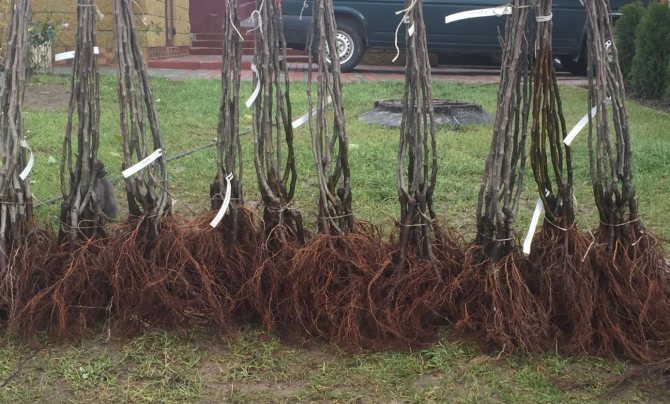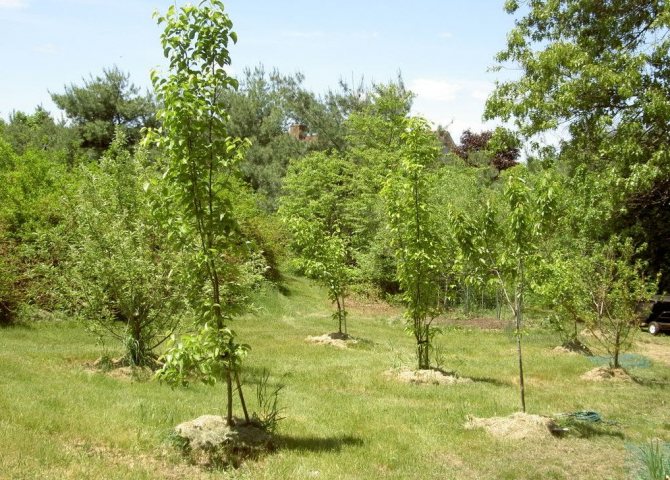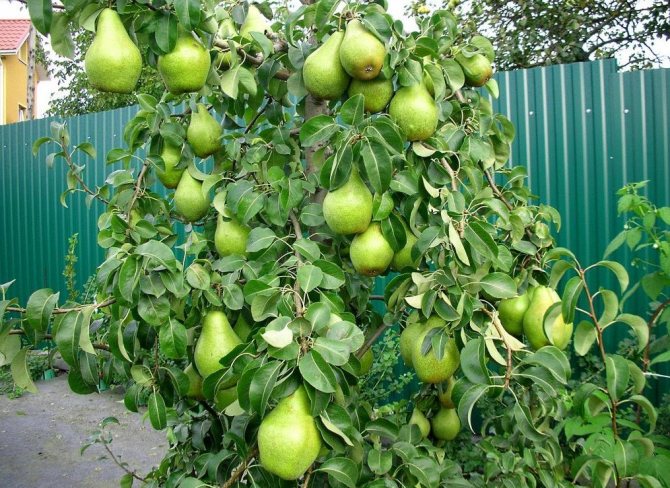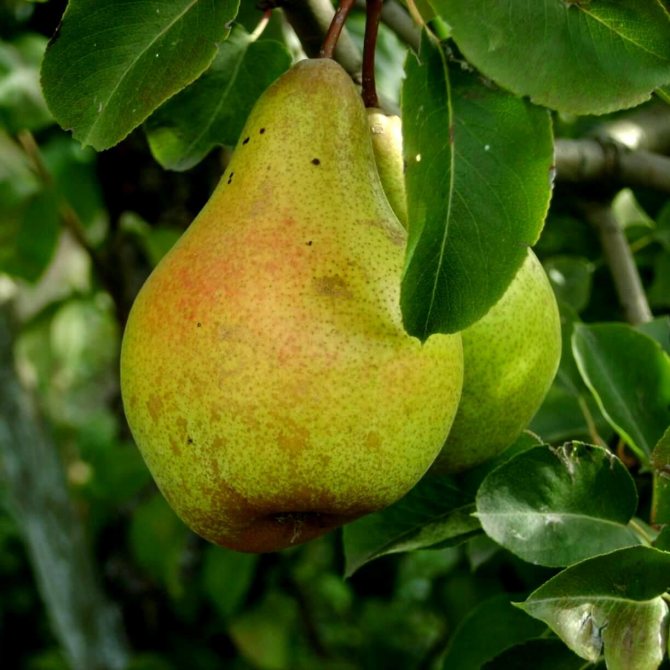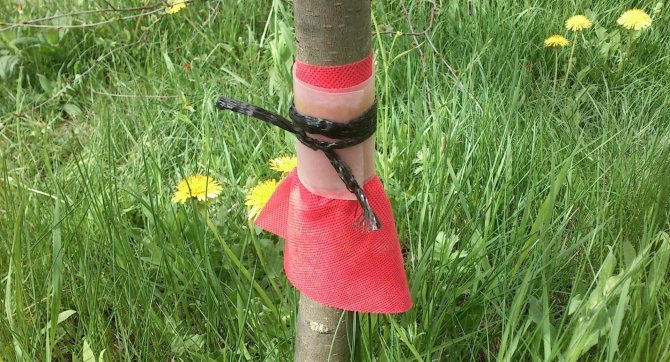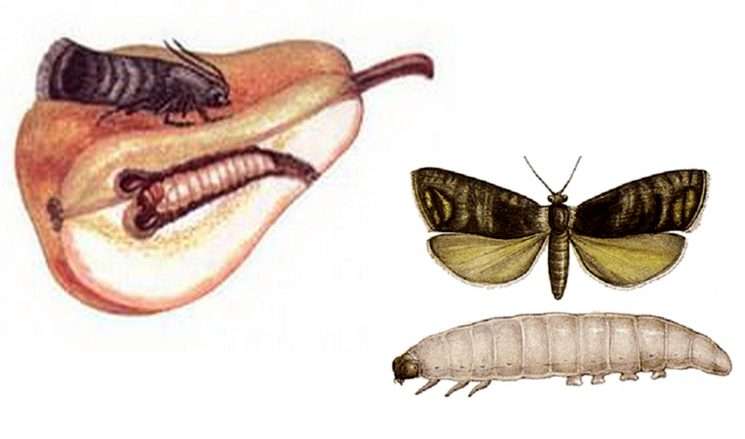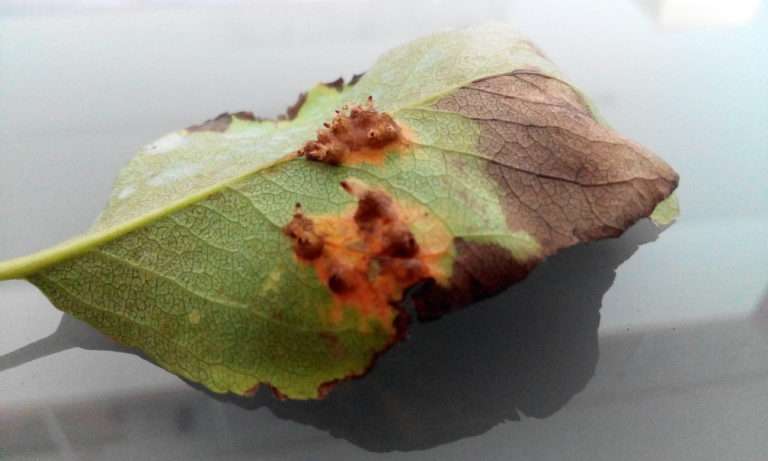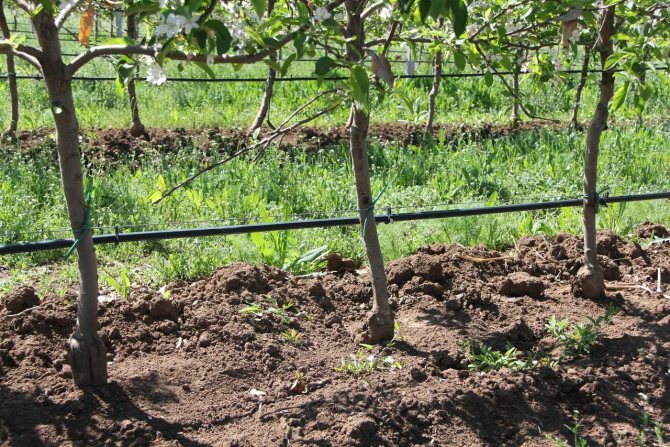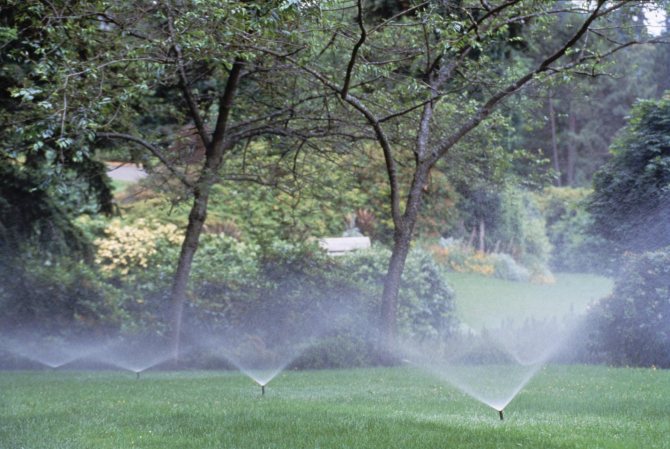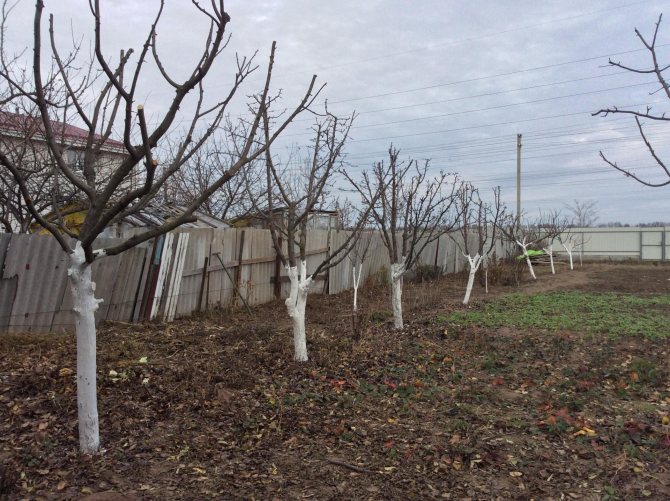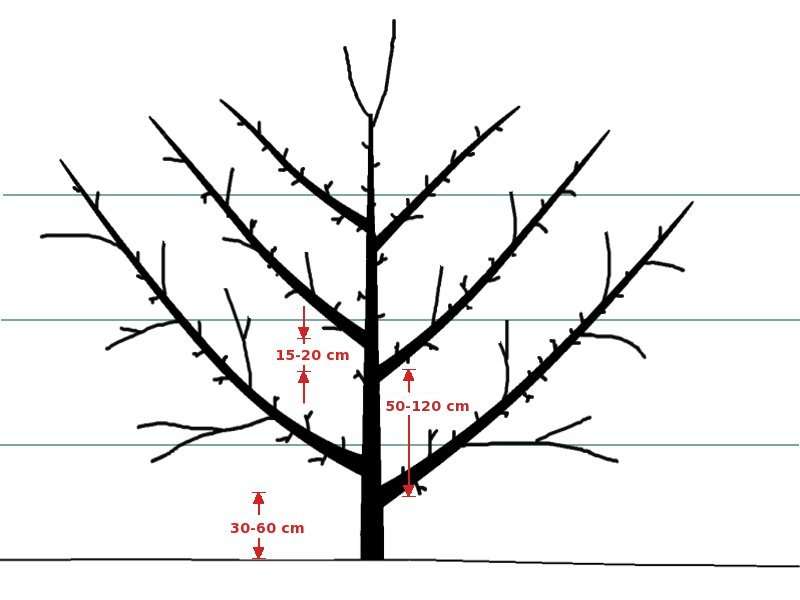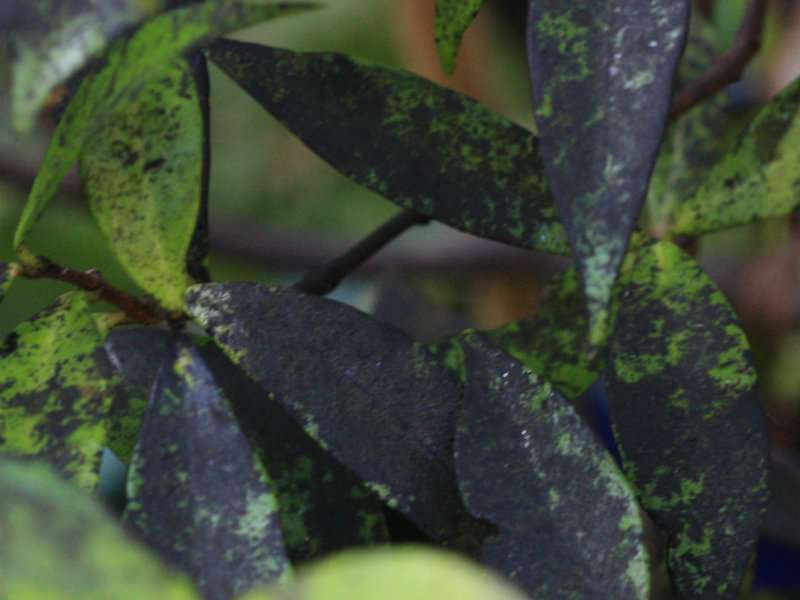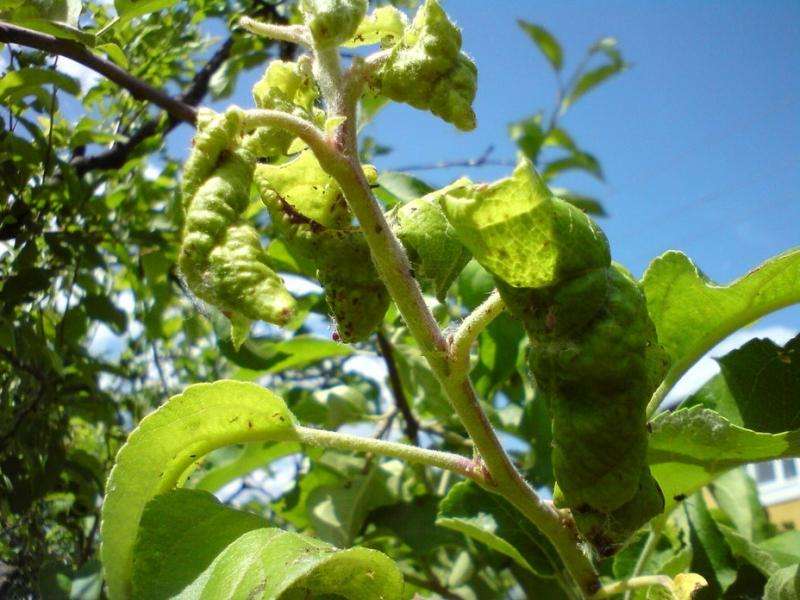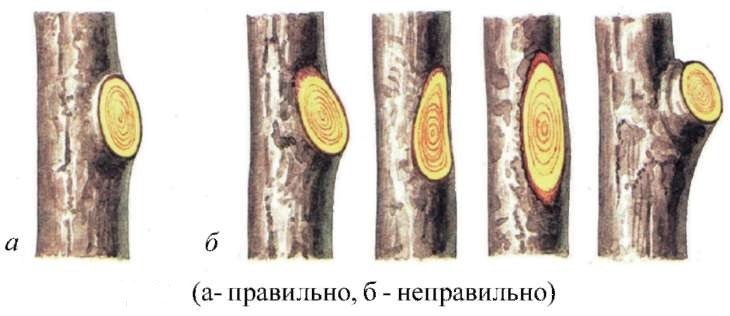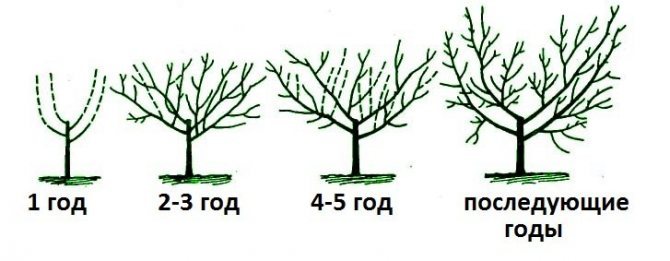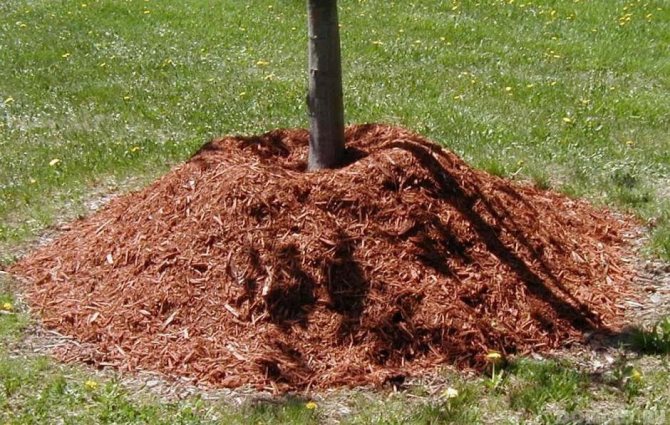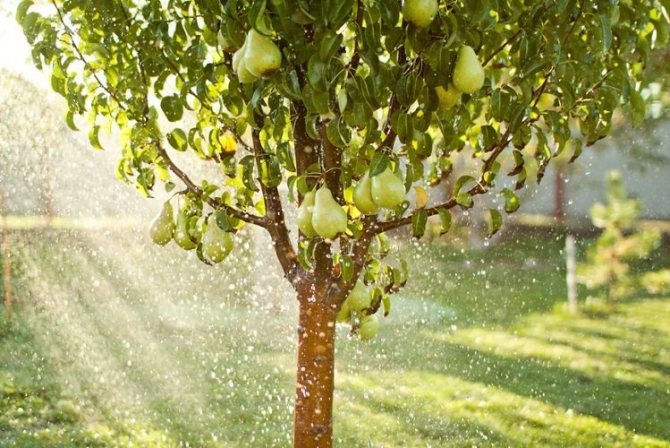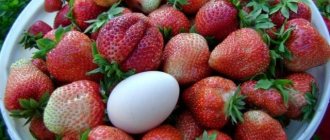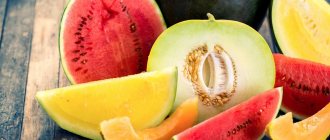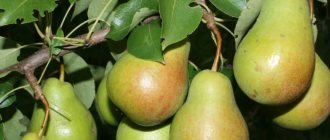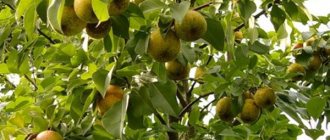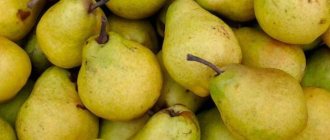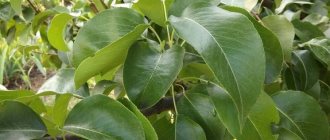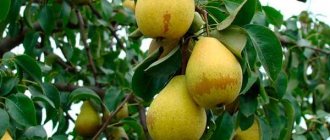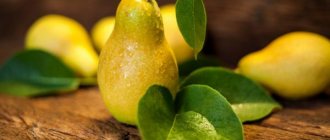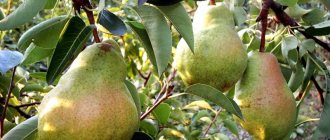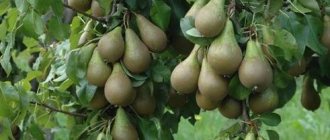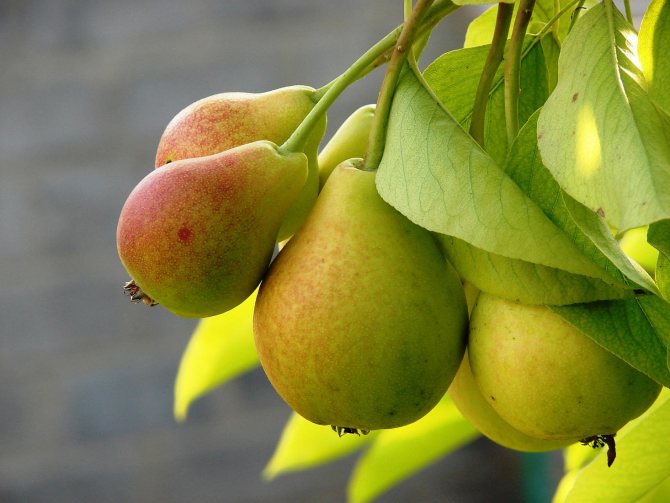
Pear Noyabrskaya belongs to the autumn varieties. It was bred in the Far East in the 50s of the last century. The creator of the Noyabrskaya pear is the breeder A.V. Bolonyaev. He crossed the winter decanca with the Ussuri pear species and got a new hybrid, which is still held in high esteem by gardeners. The variety is bred in the Khabarovsk and Primorsky Territories, as well as in the Amur Region. Due to its resistance to severe weather, this pear has taken root in other regions of Russia.
Description of the November pear
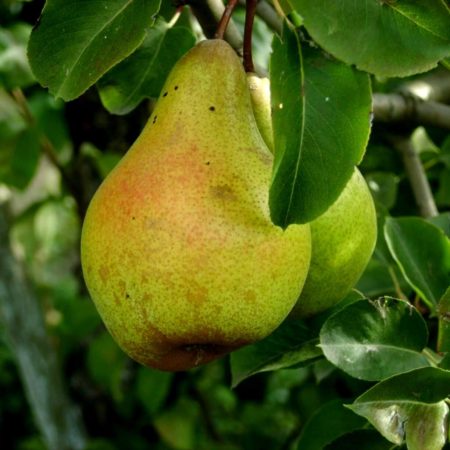

It is a tall and strong tree with branchy branches. The crown grows in the shape of a large round pyramid. The angle between the trunk and branches is 90 degrees. The leaf is dense, dense green, oval or round. Fruits begin to appear on branches that reach two or three years of age. Pear Noyabrskaya is an early ripening variety with high yields. Each tree produces up to 60 kg of fruit annually.
The fruits of a pear are medium in size, each weighing about 80 grams. When grown in warm regions, the fruits become large - up to 350 grams. They grow like a ribbed egg, with grooves and stripes on the skin. Fruit color is green with a yellowish tinge. One side is often decorated with a red blush. Symmetrical small dots are visible on the surface of the skin. Fruit with white firm pulp, juicy and sweet, with a pleasant sour taste. The pear is fragrant, strong and tasty.
It is interesting!
Pear Noyabrskaya has several other names: for example, Winter and Moldova.
This variety ripens in late autumn or early winter, so the harvest is planned in late autumn. Under unfavorable weather conditions, the fruits are harvested in early September, and they ripen safely in a dry room. It will take no more than 30 days for the pear to ripen. You can store it until February, and if you put the fruits in the freezer, they will retain their taste until next spring.
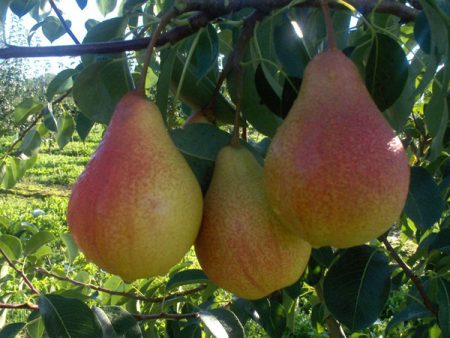

You may be interested in:
Pear Just Maria: variety description, reviews If a gardener wants to find a fruit tree for his plot that can easily endure the cold winter, he can ... Read more ...
The variety has an excellent taste, so it is used by:
- fresh;
- in jam;
- dry;
- in compote;
- in charlotte and other pastries.
For its excellent taste, the Noyabrskaya pear is considered one of the best European varieties. It is grown in many countries of Western Europe, as well as in Ukraine and Belarus.
Landing
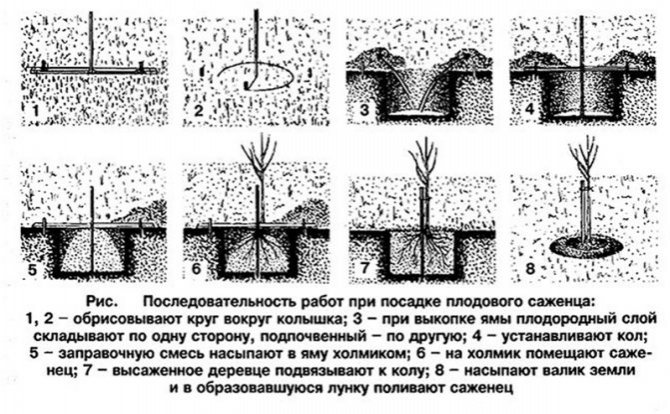

This diagram perfectly illustrates the rules for planting fruit trees, including those suitable for pears.
The main conditions for the successful growth of this culture in the garden area are a lot of sun, less drafts and an aquifer at a depth of more than a meter. The first factor makes it possible for the tree to warm up better and grow faster, the second protects against freezing in winter, the third eliminates direct contact with water, which the pear does not like so much.
Planting a seedling on the southern side of the site will be optimal to provide the necessary warmth and warming up, nearby buildings will protect from the wind blowing from the north, and good drainage or planting on a hill (in the case of a high groundwater level) will help keep the roots away from excess moisture.
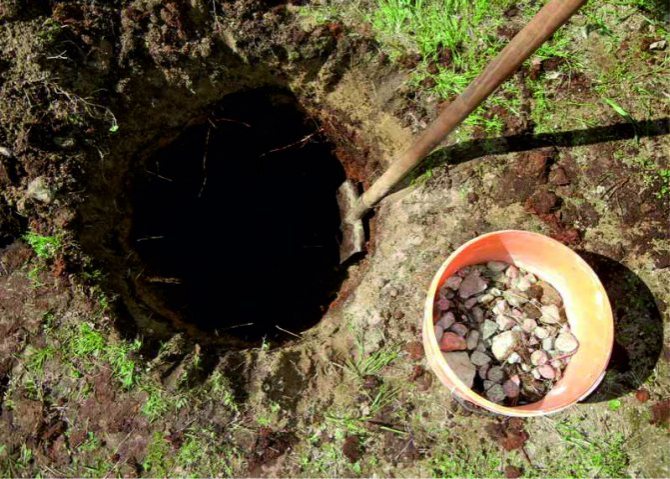

The hole should be dug in such a way that there is free space for further root growth.
The best time to plant pears is autumn. But this rule applies in the middle latitudes of Russia and the southern regions. In regions with severe winters, it is preferable to plant in the spring - for better plant survival. In both cases, the landing pit must be prepared in advance.
If the planting is in the spring, the pit is prepared in the fall, if in the fall - in two or three weeks (or better in a month). A nutrient mixture is introduced into the depression, consisting of a fertile layer of earth mixed with humus or compost (20-30 kg), superphosphate (120 g) and potassium fertilizer (60-70 g).
It is not so difficult to determine "by eye" how good the pear will be in a particular area, you can focus on the grasses and trees growing here. So, horsetail, sedge or willow will tell you that the seedling in a new place will have a hard time. But linden, maple, mountain ash or hazel will indicate the profitability of planting at this point.
A peg for a garter is driven into the center of the pit, and a seedling is placed on a mound of soil and fertilizer. If the roots are open, they are straightened in all directions down the hillside, and they begin to fill the hole with earth. This should be done evenly so that the space between the roots is filled.
Planting together is considered the best option - one person holds the tree by the stem, the second fills the foundation pit with earth. After planting, the soil around the seedling is compacted and a hole is created into which watering is performed. One plant takes 20-25 liters of water.
The root collar of the seedling should be 2–3 cm above ground level in order to be at the desired height after shrinkage.
After watering, the trunk circle is mulched with peat or compost. In the first summer, the pear is watered 2–4 times, depending on the degree of need. Each time the soil is loosened, and the trunk circle is mulched. This is how the necessary aeration of the soil and moisture preservation are achieved.
Advantages and disadvantages of the variety
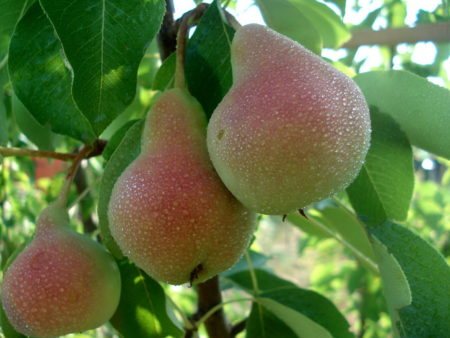

This variety has the following advantages:
- resistance to fungal and bacterial infections;
- resistance to direct sunlight;
- early maturity;
- high yields. Each tree bears fruit annually;
- suitability for sale (fruits can be stored for a long time, and they do not deteriorate during long-term transportation).
On a note!
The roots of the November pear are especially resistant to cold weather.
Of the shortcomings, different sizes of fruits are noted. Pears grow large, but it so happens that many small ones come across among them. Too picky people may not like the modest "outfit" of the Noyabrskaya pear: ribbed skin with specks and uneven sides. When planting this variety, it must be borne in mind that it will not bear fruit without pollinating trees.
Characteristics
High and stable yield - one of the many advantages of the variety.
When tested in state nurseries from trees of the Noyabrskaya variety at the age of 9 years, 54.8 c / ha were collected, at the age of 10 years - 90.6 c / ha, and the highest the yield was 212 c / ha.
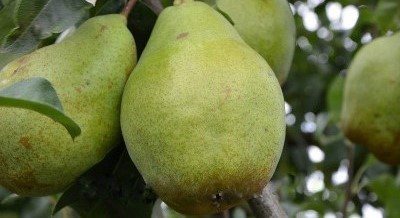

The variety is
early and begins to produce crops in the 3rd or 4th year of life... 5 years after planting, the pear already bears fruit in full force.
A faster start of fruiting can be achieved using the "Quince VA-29" stock.
Pears of the "Noyabrskaya" variety ripen in late September. However, they acquire their wonderful taste only one month after harvest.
It is worth saying that the fruits are very firmly attached to the tree and do not fall off even in strong winds. In addition, they have good keeping quality and perfectly preserved until the New Year, and sometimes a little longer.
Although "Noyabrskaya" is considered a cold-resistant variety, in climatic zones with harsh winters, it can freeze slightly, therefore it needs good insulation.
In the Amur region this variety is mainly grown in slate form, which greatly facilitates its protection from too low winter temperatures.
Pear varieties are distinguished by excellent frost resistance: Rogneda, Rossoshanskaya beautiful, Extravaganza, Duchesse and Tonkovotka.
Pollination recommendations
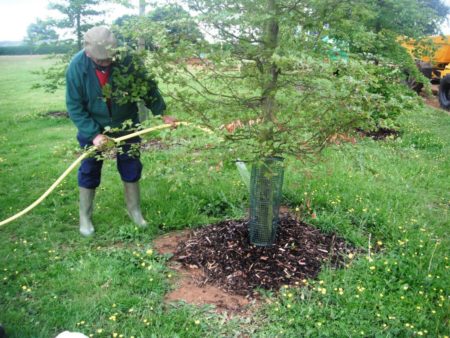

Pear Noyabrskaya is a self-fertile variety. Its flowers are not endowed with the ability to cross-pollinate. Gardeners use the following pear varieties as suitable pollinators:
- Williams (summer variety);
- Hoverla;
- Clapp's favorite;
- Conference
Pollinators are planted at the same time as the pollinated variety. You need to plant several trees of different varieties in the neighborhood. The distance between them should be 10 to 15 meters.
Briefly about the main
- Noyabrskaya is a rather old variety of pears, bred about 70 years ago in the CIS countries, most likely in Moldova. They have several names, including "Winter" and "November Moldova".
- Late autumn or winter variety, ripens in autumn.
- The fruits taste very good and are versatile in cooking, but they are not marketable at all. They can be of different shapes and sizes, yellowish or greenish shades. Therefore, they are not very suitable for sale.
- The tree is quite unpretentious in care, but does not like excessive moisture - frost resistance may decrease.
- Pears are well stored and carry transportation, therefore, in general, they are suitable for sale.
Resistance to diseases and pests, adverse conditions
Pear Noyabrskaya has good immunity. She rarely suffers from fungal and bacterial infections, but is susceptible to attacks by harmful insects. Shortly before flowering, you need to spray the crown of the tree with an insecticidal agent. After 14 days, the treatment is repeated again.
Fruit cuttings are distinguished by their amazing strength. Thanks to them, pears do not fall even in strong wind and rain. The crown and trunk become the weak point of the tree in harsh climates. In cold and humid regions, tree branches are pressed to the ground and provide them with a safe shelter.
Growing features
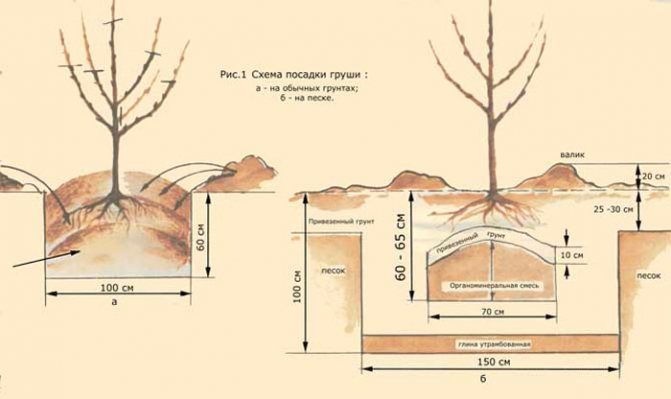

It is best to choose a landing site on the sunny side of the site. A low elevation with wind protection is recommended. It is advisable to plant it in the spring, so that during the season the plant adapts to new conditions and strengthens its immunity. The planting process is typical for the crop.
Basic steps:
- In the fall, prepare a 70 × 70 cm planting hole. Fill it with a nutritious substrate from fertile soil, humus and peat in equal proportions. Additionally, it is recommended to add 200 g of wood ash, 10 g each of superphosphate, potassium sulfate and ammonium nitrate.
- Place the peg exactly in the center of the hole, cover the surface with a film or other material to create a beneficial microclimate.
- Planting pears is best done in the morning or evening. The seedling is placed in the center of the fossa, the roots are carefully straightened.
- The tree is covered with fertile soil, leaving 2-3 cm to the level of the root collar.
- Tie the seedling to a peg, compact the soil in the area of the trunk circle, mulch with peat or sawdust.
Immediately after planting, the tree should be watered abundantly with warm water at the rate of 10 l / m2. It is advisable to carry out the first feeding not earlier than 10-14 days from the moment of planting. The tree is vigorous, when planting, an interval of 2-4 m between trees should be observed, about 3-5 m between rows.
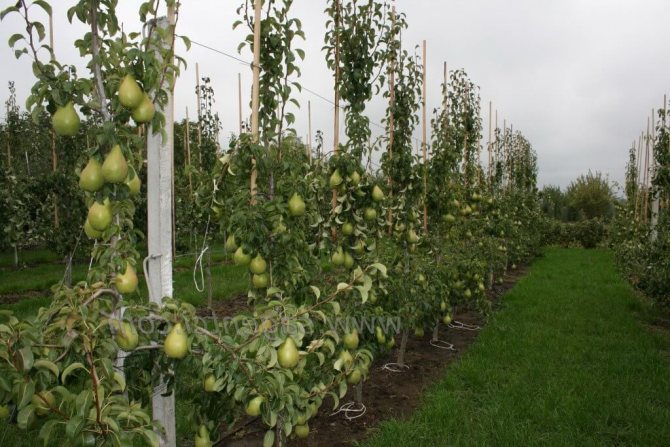

Pear Noyabrskaya is suitable for novice gardeners, it is characterized by unpretentious care, simple planting, and infection with diseases and pests is extremely rare. It is especially important to follow all the necessary procedures in the first year of growth, when the plant is actively growing and developing.
Care requirements:
- a pear of this variety prefers a moderately moist soil, it is advisable to water it once every 2-3 weeks at the rate of 10-12 liters per plant.It is advisable to apply water by sprinkling so that the plant receives moisture through the leaves;
- in the first year of growth, it is necessary to regularly loosen the soil to increase aeration, remove weeds;
- from the first year you can start pruning. The procedure is purely sanitary. In an annual plant, the central shoot is shortened by half, and then pruning by 10-15 cm is required. For adults, all dry, diseased and deformed shoots are cut off. In the spring, it is advisable to form a crown by cutting off excess skeletal branches;
- a fairly thick layer of mulch should be maintained throughout the season. The optimum thickness is 20-30 cm. Sawdust, dry peat or fallen leaves are suitable as material;
- top dressing is applied three times during the season - in spring, at the time of ovary formation and in autumn. You can use both organic matter (mullein solution in a ratio of 1:10) and complex mineral fertilizer. You need to make top dressing only at the root.
The variety has a high frost resistance, even when grown in cold regions, a shelter is not carried out. In the fall, before the onset of frost, it is enough just to add a layer of mulch, and also to cut off all weak shoots.
Possible diseases and their treatment
The pear of the Noyabrskaya variety has a strong immunity to scab, powdery mildew and other diseases characteristic of the culture. When grown in humid and cool climates, there is a risk of pest infestation.
During the season, it is advisable to carry out preventive treatment with a chemical insecticide (Karbofos, Iskra, Agravertin or Kinmiks) three times. Spraying is carried out before bud swelling, before flowering and after fruit setting.
During the procedure, all vegetative parts are sprayed, and the area of the trunk circle, where insect larvae and eggs are often found, is watered.
Agrotechnical measures
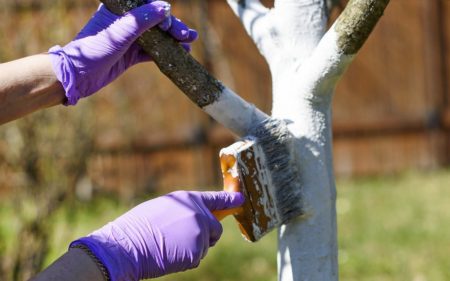

The best place for planting the Noyabrskaya pear is in the southern part of the site, which is located on a hill and protected from strong winds.
Advice!
In the cold region, this variety is planted in spring. By the winter cold, the trees will have time to get stronger. In warm climates, pear trees are planted in autumn.
The landing stages look like this:
- 6 months before planting, dig a hole, taking into account the root system of an adult tree (70x70 cm);
- before planting, the nutrient mixture is poured into the hole. It consists of rotted compost, ash, phosphate and potassium-based fertilizer;
- a peg is placed in the center of the hole;
- the seedling is installed strictly in the center of the fossa, with a neat spreading of its root system;
- sprinkle the roots with earth;
- a distance of 2 to 3 cm should remain to the root neck;
- the planted tree is tied to a peg.
It remains to water and mulch the earth. For mulching, use sawdust or other organic substances.
In the summer after planting, young seedlings are watered 3 to 4 times a day, with preliminary loosening of the earth. The soil in which the trees are located should always be slightly damp. In the dry season, rain irrigation is used. Thanks to him, trees receive moisture through the foliage.
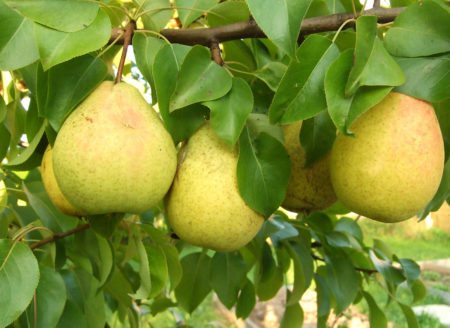

Until the young tree has matured, weeds are regularly harvested near it. For an adult pear, weeds are not dangerous. For them, loosening the soil is enough. Young one-year-old trees need to form a crown. For this, the main branch is made half as short. In biennial trees, skeletal branches are given the necessary shape. Ripe pears are pruned in spring and autumn. Old branches are pruned with it, weak and sick ones are removed.
Recommendation!
By shortening all branches by 10-15 cm annually, the pear will quickly begin to bear fruit.
In a cold winter without snow cover, seedlings can die. Before the winter season, the soil around them should be covered with a layer of peat bog 30 cm thick.Sanitary pruning is carried out for old trees in spring and autumn, removing old, dry and diseased branches. In spring and summer, pears are fed with organic and mineral fertilizers. After the autumn harvest, it is fertilized with ripe manure, compost or ash.
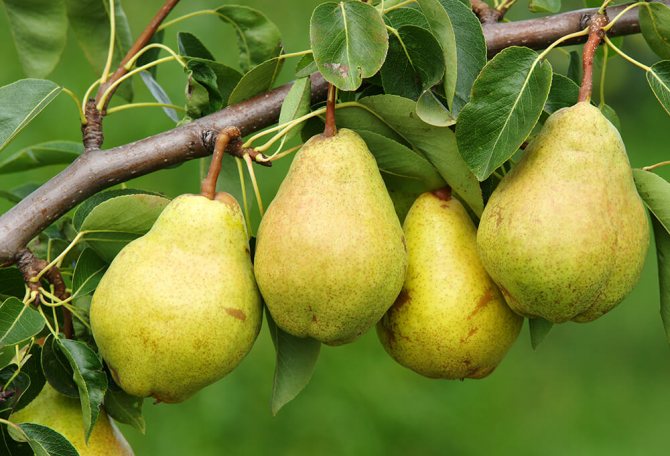

You may be interested in:
Now we know the reasons and what to do if a pear drops fruit ovaries Drying and subsequent dropping of the ovaries on the pear leads to a loss of ½ of the yield. The peak of the development of pathology is the end ... Read more ...
Basic care
Watering
In the first summer after planting, a pear requires watering from two to five times (about 30-50 liters for each tree), depending on weather conditions and the depth of groundwater. The earth must not be allowed to dry out. This will significantly slow down the growth of shoots, delay the fruiting period, and reduce the quantity and quality of fruits. After each watering, the young tree needs to ensure sufficient air exchange by loosening the soil. And with the help of mulching, preserve the stably moist microclimate of the root system necessary for the pear and prevent the growth of weeds.
At the end of July, watering is stopped to avoid the build-up of late shoots, which most often cannot survive the winter.
The abundance of watering does not change with the age of the tree. A feature is the dependence of watering on the life cycle of the tree. Watering an adult pear is necessary:
- during the flowering period;
- on the eve of the formation of the ovary (early June);
- 2 - 3 weeks before fruit ripening (early September).
The most effective way to water a pear is by sprinkling - moisture is delivered not only to the roots, but also to the branches and leaves.
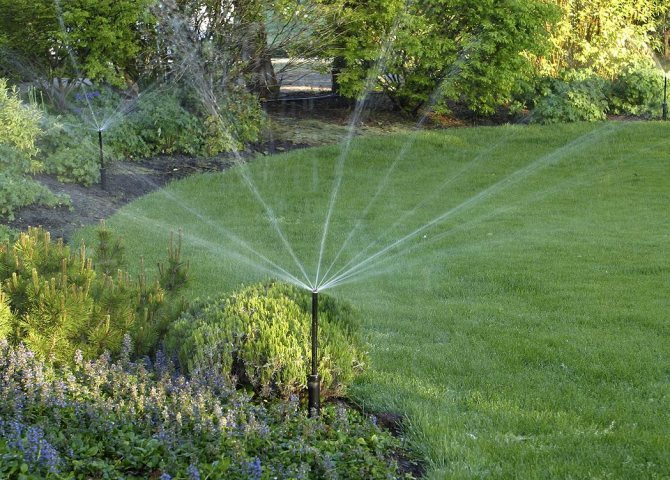

Imitation of rain moisturizes not only the roots, but also the crown
Important: sprinkling can be done only in the early morning, in the evening or when overcast. Otherwise, sunburn cannot be avoided.
Top dressing
Pear seedlings require feeding with nitrogen-containing fertilizers to stimulate growth and form a powerful crown, ready for abundant fruiting. In the first year, nitrogen is applied in mid-May. Repeated - in mid-June. With intensive growth of shoots for the next year, a one-time application of nitrogen fertilization in early May is sufficient. To stimulate fruiting in the third and fourth years, nitrogen application should be limited as much as possible. In the future, you should choose the necessary methods and scales of fertilizing, depending on the condition of the tree and the type of soil.
Basic methods and norms of pear feeding - table
| Fertilizer | Type of feeding | Feeding period | Introduced substances and their proportions | Periodicity |
| Saltpeter | Root. | In spring - during bud swelling and flowering. | 30 g per 1 m². Diluted with water in a ratio of 1:50. Can be used dry in wet weather. | Once in each period. |
| Urea (urea) | Root. | In spring - during bud swelling and flowering. | 80-120 grams per tree. It is diluted in 5 liters of water or poured dry, as is the case with saltpeter. | Once in each period. |
| Nitroammofoska or organic fertilizers | Root. | May. | 1 kg for 200 liters of water. For one tree - 3 buckets of mortar. | Once after flowering. |
| Urea (urea) | Foliar. | July - early September. | 30-50 grams per 10 liters. For one tree - 2 liters of solution. | Top dressing with urea is alternated with top dressing with phosphorus and potassium (30 g each). The interval between dressings is two weeks. |
| Complex mineral fertilizer | Root. | The end of September is after the harvest. | Granular superphosphate - 2 tbsp. l. 10 liters of water - 1 m² portion. | Once after harvest. |
| Wood ash | Root. | October November. | 150 gr per 1 m² (to a depth of 10 cm). | Once in preparation for winter. |
Pruning
In April (before the start of sap flow) of the year following planting, pruning should be performed in order to form the crown. In an unbranched tree, the top is cut off 20 cm above the planned site of the formation of skeletal branches.Trees with lateral shoots are thinned out, frozen branches and low-growing branches are removed. The conductor is shortened to stimulate branching. In the future, the crown is formed according to the presented scheme.
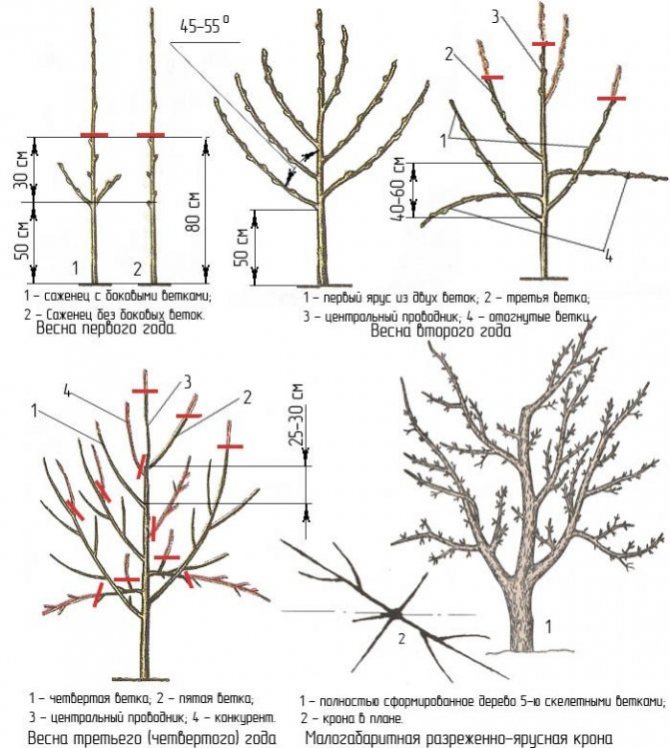

The formation of a sparse crown is a guarantee of high yields
Sanitary pruning is essential for the regular rejuvenation of the tree. Its essence boils down to the removal of old, dry, pest-affected and growing shoots inside the crown. Pruning powerful healthy branches should be done in moderation - no more than 1/4 of the crown.
The optimal time for such sanitization is October... During this period, the tree already sheds its foliage and goes into a state of winter dormancy. The better the wounds heal after pruning before the onset of frost, the easier the tree will endure the winter.
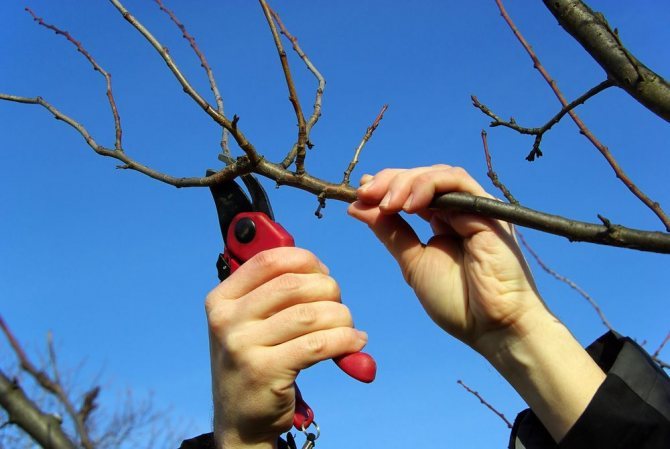

Formative pruning is done in spring, sanitary pruning - in autumn
Pear pruning - video
Preparing for winter
Pear Noyabrskaya is characterized by high frost resistance, therefore, does not require shelter for the winter. However, extra care will not hurt her. This is especially important for young trees. The most important thing is to protect the root system from freezing. Mulching the near circle with peat with a layer of at least 30 cm will help to cope with this problem.
Gardeners reviews
Vasily (Moscow region):
“I inherited the Noyabrskaya pear from my grandfather. This tree was bred in Soviet times. Does not require special care, it grows by itself. Sometimes I fertilize it with rotted manure, cut dry branches in spring and autumn. The fruits are small, but very sweet and tasty, they are stored for a long time. The tree bears a harvest every year. "
Marina (Murmansk):
“A November pear is growing on our site. We love our tree and take great care of it. The fruits grow large, firm and sweet. We cook pear jam, often bake charlotte. If pears lie for two months, they become especially juicy and tasty. They say that such pears can be stored until next year, but we can't do it: we eat them very quickly. "
Pear Noyabrskaya is an unpretentious tree with a modest color of fruit. Due to its durability, it pleases the owner with a bountiful harvest every year.
Growing rules
Growing November Winter is not difficult at all, so this variety is perfect even for novice gardeners. Particular attention should be paid to the self-fertility of this pear - pear trees with suitable flowering periods must necessarily grow on or near the site.
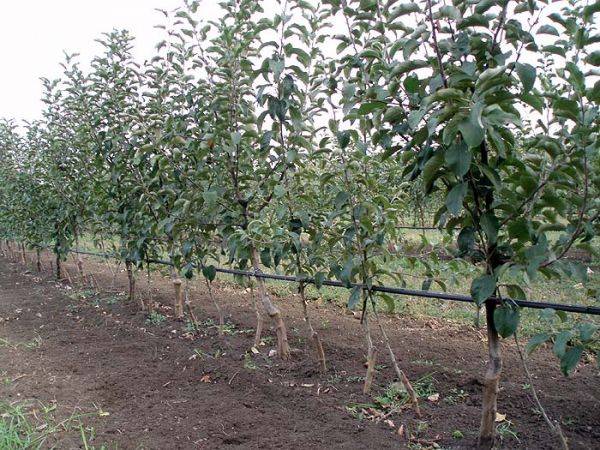

Planting a tree
It is better to plant Noyabrskaya on the southern side of the site, choosing a place located on a small hill and protected from the north wind or draft.
The landing stages should be as follows:
- Six months before planting the seedling, you need to dig a hole. Its dimensions should be comparable to the root system of the tree, on average, it is 70x70 cm.
- The pit is filled with a mixture of soil, humus, superphosphate, wood ash and potash fertilizer.
- A peg is installed in the center of the pit, a seedling will subsequently be tied to it.
- Place the seedling in the center and straighten its roots.
- Gradually sprinkle the root system of the seedling with earth, leaving 2-3 cm to the root collar.
- A tree is tied to a peg.
- Water and mulch the soil around the tree.
In the first summer after planting, the November pear must be watered 3-4 times. Each time before watering, the soil is loosened to improve soil aeration.
Pear tree care
The primary task of the gardener is to create conditions for the normal development of the pear tree and to minimize the risk of disease. In order for a tree to quickly enter the fruiting phase, develop normally and please with stable yields, it needs such care:
- Pear Noyabrskaya loves slightly moistened soil, so it is recommended to water it during periods of drought. Sprinkling irrigation is especially favorable, when the tree receives moisture not only through the roots, but also through the leaves.
- While the pear is young, weeds should be removed regularly around it. For mature trees, the grass will not do any harm, but it is better to loosen the soil around the trunk.
- Pruning is especially important for young trees. In the first year after planting, the gardener should start forming the crown. In a one-year-old seedling, the central shoot is shortened by half, skeletal branches are formed for two-year-old trees. If you shorten all the shoots by 10-15 cm annually, you can achieve faster tree development and early fruiting. In mature pears of the Noyabrskaya Zimnyaya variety, old, dry and diseased shoots are cut out, sanitary or rejuvenating spring pruning is regularly carried out (shown in the photo).
- Seedlings of November Winter can freeze out if the winter is snowless and cold. To prevent this, the soil around the trunk is mulched with peat, the layer thickness should be about 30 cm. As a rule, mature trees do not need shelter.
- It is necessary to feed the variety Noyabrskaya Zimnyaya with both organic matter and mineral components. In the fall, after harvesting, humus, rotted manure, wood ash or compost can be added. During the season, the soil is enriched with phosphorus, potassium, nitrogen, nitrate or urea.
- Noyabrskaya has immunity to fungal and bacterial infections, but insects may well harm both the tree itself and the crop. To prevent this, the crown is sprayed with special agents before flowering. The treatment is repeated after a couple of weeks.
You can harvest the November pear already at the end of September. But, if the weather permits, it is better not to rush: the fruits adhere perfectly to the branches and do not deteriorate.

